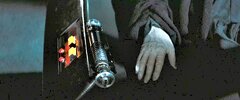You are using an out of date browser. It may not display this or other websites correctly.
You should upgrade or use an alternative browser.
You should upgrade or use an alternative browser.
Luke ROTJ V2 lightsaber
- Thread starter ob1al
- Start date
I see you want this… don’t youView attachment 1703798
I mean… this one is preeetty close
same thing could he said for the Greedo Killer blaster... but people don't consider it the heroThe v1 got the dedicated close up shot. That is the definition of a hero prop.
The v1 got the dedicated close up shot. That is the definition of a hero prop.
Whoa whoa whoa. Those are fighting words Mr Han, luke catching the v2 was a pretty good close up
You guys know both can be true, right? In movies there can be more than one "hero" prop. It just designates any prop that has all the details and effects for closeups.
A bit of Prop Philosophy:
The V2 was apparently thrown together in a hurry, since they seemingly needed a new saber prop on the spot for ROTJ. The V2 appears throughout filming, and is the de facto hero. Because it HAD to be.
HOWEVER, when they got to filming the insert shots of the cave build and Vader examining it, they did NOT use the V2, which was surely still available. Instead, they cleaned up the Yuma Stunt, and gave it hero features and electronics. This indicates a conscious awareness that the V2 was not ready for prime-time, and also that the in-universe saber was supposed to be newly-constructed, rather than dented and weathered. Hence, the V1, which has been pretty consistently used as the basis for replicas/merchandise/key art.
I suppose the correct answer is “both the V1 AND the V2 are heroes, depending on your point of view”, but the V1 is the official choice, as it appears in most other media (and the execrable Disney Trilogy). And the official website probably just used the V2 screencap because it’s a decent medium shot of the saber from the film.
On a similar note, there are people who hate the prequel versions of the OT sabers. The Skinnyflex and the OWK3 are sleek, idealized versions of the original found-parts props, and work perfectly fine onscreen in representing them, which is all they were made to do. I’m a Graflex man all the way, but the Skinnyflex still does the job it was intended to do. The question then becomes, “Which is the canonical version?”. Outside of the context of watching the films proper, there are differences between them which can’t be reconciled.
It crosses wires in my brain to see comic book and other art showing Luke using the Skinnyflex instead of the Graflex in OT-era ancillaries. Personally, I consider the Graflex to be the canonical version, because it has both tenure and All-Time Iconic Prop status. Same with the MK1 and the MPP. The Skinnyflex is just an interpretation used as a stand-in for one film. All other appearances (including the execrable Disney Trilogy and KENOBI show) use the Graflex.
So, when it comes to questions like this, I think the individual circumstances have to be considered, such as amount of screentime, WHY a certain version was used, and how marketing/licensing handles the matter.
None of this stops the V2 from being awesome, of course.
The V2 was apparently thrown together in a hurry, since they seemingly needed a new saber prop on the spot for ROTJ. The V2 appears throughout filming, and is the de facto hero. Because it HAD to be.
HOWEVER, when they got to filming the insert shots of the cave build and Vader examining it, they did NOT use the V2, which was surely still available. Instead, they cleaned up the Yuma Stunt, and gave it hero features and electronics. This indicates a conscious awareness that the V2 was not ready for prime-time, and also that the in-universe saber was supposed to be newly-constructed, rather than dented and weathered. Hence, the V1, which has been pretty consistently used as the basis for replicas/merchandise/key art.
I suppose the correct answer is “both the V1 AND the V2 are heroes, depending on your point of view”, but the V1 is the official choice, as it appears in most other media (and the execrable Disney Trilogy). And the official website probably just used the V2 screencap because it’s a decent medium shot of the saber from the film.
On a similar note, there are people who hate the prequel versions of the OT sabers. The Skinnyflex and the OWK3 are sleek, idealized versions of the original found-parts props, and work perfectly fine onscreen in representing them, which is all they were made to do. I’m a Graflex man all the way, but the Skinnyflex still does the job it was intended to do. The question then becomes, “Which is the canonical version?”. Outside of the context of watching the films proper, there are differences between them which can’t be reconciled.
It crosses wires in my brain to see comic book and other art showing Luke using the Skinnyflex instead of the Graflex in OT-era ancillaries. Personally, I consider the Graflex to be the canonical version, because it has both tenure and All-Time Iconic Prop status. Same with the MK1 and the MPP. The Skinnyflex is just an interpretation used as a stand-in for one film. All other appearances (including the execrable Disney Trilogy and KENOBI show) use the Graflex.
So, when it comes to questions like this, I think the individual circumstances have to be considered, such as amount of screentime, WHY a certain version was used, and how marketing/licensing handles the matter.
None of this stops the V2 from being awesome, of course.
Last edited:
View attachment 1705096Do movie posters count for hero status?
Does it play in? (Rhetorical question)
…that WAS the one they chose to photograph. Says a lot.
CopperRevan
Master Member
Yeah, i never understood the reasoning behind the "ISYHCANL" scene being the determining factor...I mean, Luke constructs it, it is new per se but from what? Probably old parts. Luke himself is a little rough around the edges in the context of Jedi training. He trains with it(assumably) then battles with it on Jabbas sailbarge...Whatever version it is, it's going to get dirtied and scarred up by the time Vader holds it so to "clean up" the Yuma to me is ridiculous...i get what the marketing was going for eventually but doesn't make sense in the context of the movie seeing that the deleted cave scene never made it in. In 1983 when they released the Return of the Jedi Storybook, which i still have, it has the Yuma (even though i didn't know what it was) on the cover...that became and still is my definitive "Hero".A bit of Prop Philosophy:
The V2 was apparently thrown together in a hurry, since they seemingly needed a new saber prop on the spot for ROTJ. The V2 appears throughout filming, and is the de facto hero. Because it HAD to be.
HOWEVER, when they got to filming the insert shots of the cave build and Vader examining it, they did NOT use the V2, which was surely still available. Instead, they cleaned up the Yuma Stunt, and gave it hero features and electronics. This indicates a conscious awareness that the V2 was not ready for prime-time, and also that the in-universe saber was supposed to be newly-constructed, rather than dented and weathered. Hence, the V1, which has been pretty consistently used as the basis for replicas/merchandise/key art.
I suppose the correct answer is “both the V1 AND the V2 are heroes, depending on your point of view”, but the V1 is the official choice, as it appears in most other media (and the execrable Disney Trilogy). And the official website probably just used the V2 screencap because it’s a decent medium shot of the saber from the film.
On a similar note, there are people who hate the prequel versions of the OT sabers. The Skinnyflex and the OWK3 are sleek, idealized versions of the original found-parts props, and work perfectly fine onscreen in representing them, which is all they were made to do. I’m a Graflex man all the way, but the Skinnyflex still does the job it was intended to do. The question then becomes, “Which is the canonical version?”. Outside of the context of watching the films proper, there are differences between them which can’t be reconciled.
It crosses wires in my brain to see comic book and other art showing Luke using the Skinnyflex instead of the Graflex in OT-era ancillaries. Personally, I consider the Graflex to be the canonical version, because it has both tenure and All-Time Iconic Prop status. Same with the MK1 and the MPP. The Skinnyflex is just an interpretation used as a stand-in for one film. All other appearances (including the execrable Disney Trilogy and KENOBI show) use the Graflex.
So, when it comes to questions like this, I think the individual circumstances have to be considered, such as amount of screentime, WHY a certain version was used, and how marketing/licensing handles the matter.
None of this stops the V2 from being awesome, of course.
So who do we actually have to thank for the V2 designation? I mean who was first to use it? Was it Master Replicas? Or did they use that because it was already established?So it's about we call this the hero prop!
But I'm afraid it is far too late for that and this lightsaber will be forever known in our community as the "version 2".
Last edited:
It happened here. The cleanest-looking version of the prop, the insert closeup version in Vader's hands, by definition would be the hero, and was analyzed first. Then people noticed another prop and it had to be called something.
Its "2" designation is more about the order in which it was analyzed and discussed rather than, even then, an erroneous assumption it was made later.
Its "2" designation is more about the order in which it was analyzed and discussed rather than, even then, an erroneous assumption it was made later.
I'd say the Chrises of Parts of Star Wars.So who do we actually have to thank for the V2 designation? I mean who was first to use it? Was it Master Replicas? Or did they use that because it was already established?
Hello everyone! 
So, what do I do if I want to make myself a V2? Is there any place on here where I can get all the measurements?
I’m learning how to use a mill right now, and in a few weeks time, I’m going to start my lathe training. There’s an indexing head I can use, too.
What better use for all those machines can there be, but making a lightsaber!
At the moment, I think I want to make one that looks like the V2, but can be opened, so that I can build a motor for a rotating fibre glass stick into it later.
So, what do I do if I want to make myself a V2? Is there any place on here where I can get all the measurements?
I’m learning how to use a mill right now, and in a few weeks time, I’m going to start my lathe training. There’s an indexing head I can use, too.
What better use for all those machines can there be, but making a lightsaber!
At the moment, I think I want to make one that looks like the V2, but can be opened, so that I can build a motor for a rotating fibre glass stick into it later.
There are blueprints online for the V1 saber with measurements, though they aren't 100% correct. Not sure about the V2.Hello everyone!
So, what do I do if I want to make myself a V2? Is there any place on here where I can get all the measurements?
I’m learning how to use a mill right now, and in a few weeks time, I’m going to start my lathe training. There’s an indexing head I can use, too.
What better use for all those machines can there be, but making a lightsaber!
At the moment, I think I want to make one that looks like the V2, but can be opened, so that I can build a motor for a rotating fibre glass stick into it later.
Of course, none of the saber makers will give away the measurements they spent countless hours nailing down, and create a situation where others could then compete with them by offering the same product, or bypass their sales and create their own personal copy.
Thank you. Yeah, I kind of expected that there might be a kind of secret around the true measurements. On the other hand side, I’d like it better if such information would be accessible to everyone in the community, since there’s hardly any way to arrive at a consensus about what is screen accurate and what is not, without the help of the community.There are blueprints online for the V1 saber with measurements, though they aren't 100% correct. Not sure about the V2.
Of course, none of the saber makers will give away the measurements they spent countless hours nailing down, and create a situation where others could then compete with them by offering the same product, or bypass their sales and create their own personal copy.
Ok, so I’ll look for the V1 measurements and see if I can make them into something that I like. The copper part of that saber is something that I like somehow.
Will I find plans for the V1 on the RPF, or somewhere else? And how do I know if I have found the (almost) correct ones?
Sym-Cha
Master Member
These blueprints come from the wannawanga website and are made by the fabulous Roy Gilsing :

V2 ... you can use the G R A F L E X clamp, if you have purchased one, to guestimate the scale of the other parts of the saber :

Sizes on the V3 6 x 5 x 29 cm

And finally a schematic eventhough mind you most measurements are more for an idealised lightsaber than a screen-accurate one :

I hope this will give you a starting point and do share your work in progress once you are milling and lathing a lightsaber to your hearts content!
Chaïm
V2 ... you can use the G R A F L E X clamp, if you have purchased one, to guestimate the scale of the other parts of the saber :
Sizes on the V3 6 x 5 x 29 cm
And finally a schematic eventhough mind you most measurements are more for an idealised lightsaber than a screen-accurate one :
I hope this will give you a starting point and do share your work in progress once you are milling and lathing a lightsaber to your hearts content!
Chaïm
BRRogers
Master Member
This image isn’t bad for printing and scaling but it was based on a casting and the dimensions also don’t add up.
278mm should be the length from from the bottom of the pommel to the emitter face. That’s true of the V2 (depending on how the pommel is Inset) as well as the V3 and the even the static obi wans
Thank you so much! These will be very helpful to turn and mill one (of each of them) for my own delight. 
I can't wait to start working on them, and usually I am allowed to take photos inside the training workshop. But the next few weeks will be hot working, after that we are going to start with the lathe, afaik. At least, there will be something that I can show you somewhere in 2023. ^^
I can't wait to start working on them, and usually I am allowed to take photos inside the training workshop. But the next few weeks will be hot working, after that we are going to start with the lathe, afaik. At least, there will be something that I can show you somewhere in 2023. ^^
Last edited:
This week, we've started lathe training finally. I am PROBABLY able to make most of the saber now.
Unfortunately, my trainer has gone on a three week holiday this morning, but before that, he gave me some aluminum leftovers, plus I was allowed to cut off a piece from the long expensive aluminum rod, for the longer saber parts. I plan to make a) the pommel, b) the part carrying the Graflex clamp, c) the groovy part d) the bronze part, and e) the emitter as separate parts, so that I can screw the saber open, and I want to make the bronze part twice, but one from aluminum, so I can change the look.
Today, we were doing some more training cuts, but were allowed to use our own measurements, so I took the provided 20mm steel shaft, and turned it into a miniature emitter.
If there is enough leftover from the steel shaft next week, I can probably train the cuts for the "real" lightsaber by making a whole miniature saber as a keychain first.

I have built this in Shapr3D, using the plans you gave me, but changed some details beforehand in Photoshop, by comparing the plans and the photos of the original.
What do you think of my pommel, does it look legit?
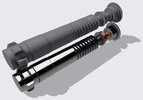
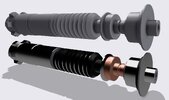
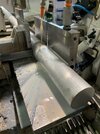 Cutting the big aluminum rod.
Cutting the big aluminum rod.
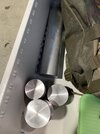 Aluminum leftovers that can still be turned into saber parts.
Aluminum leftovers that can still be turned into saber parts. 
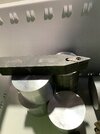 A cutting tool that'll be good for the grooves hopefully.
A cutting tool that'll be good for the grooves hopefully.
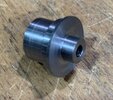
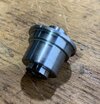 1:2.35 scale emitter made from steel.
1:2.35 scale emitter made from steel.
Unfortunately, my trainer has gone on a three week holiday this morning, but before that, he gave me some aluminum leftovers, plus I was allowed to cut off a piece from the long expensive aluminum rod, for the longer saber parts. I plan to make a) the pommel, b) the part carrying the Graflex clamp, c) the groovy part d) the bronze part, and e) the emitter as separate parts, so that I can screw the saber open, and I want to make the bronze part twice, but one from aluminum, so I can change the look.
Today, we were doing some more training cuts, but were allowed to use our own measurements, so I took the provided 20mm steel shaft, and turned it into a miniature emitter.
If there is enough leftover from the steel shaft next week, I can probably train the cuts for the "real" lightsaber by making a whole miniature saber as a keychain first.
I have built this in Shapr3D, using the plans you gave me, but changed some details beforehand in Photoshop, by comparing the plans and the photos of the original.
What do you think of my pommel, does it look legit?


 Cutting the big aluminum rod.
Cutting the big aluminum rod. Aluminum leftovers that can still be turned into saber parts.
Aluminum leftovers that can still be turned into saber parts.  A cutting tool that'll be good for the grooves hopefully.
A cutting tool that'll be good for the grooves hopefully.
 1:2.35 scale emitter made from steel.
1:2.35 scale emitter made from steel.
Last edited:
That looks awesome Geri! Excited to see the finished product. 
Similar threads
- Replies
- 9
- Views
- 1,133
- Replies
- 13
- Views
- 1,876
- Replies
- 3
- Views
- 1,830

